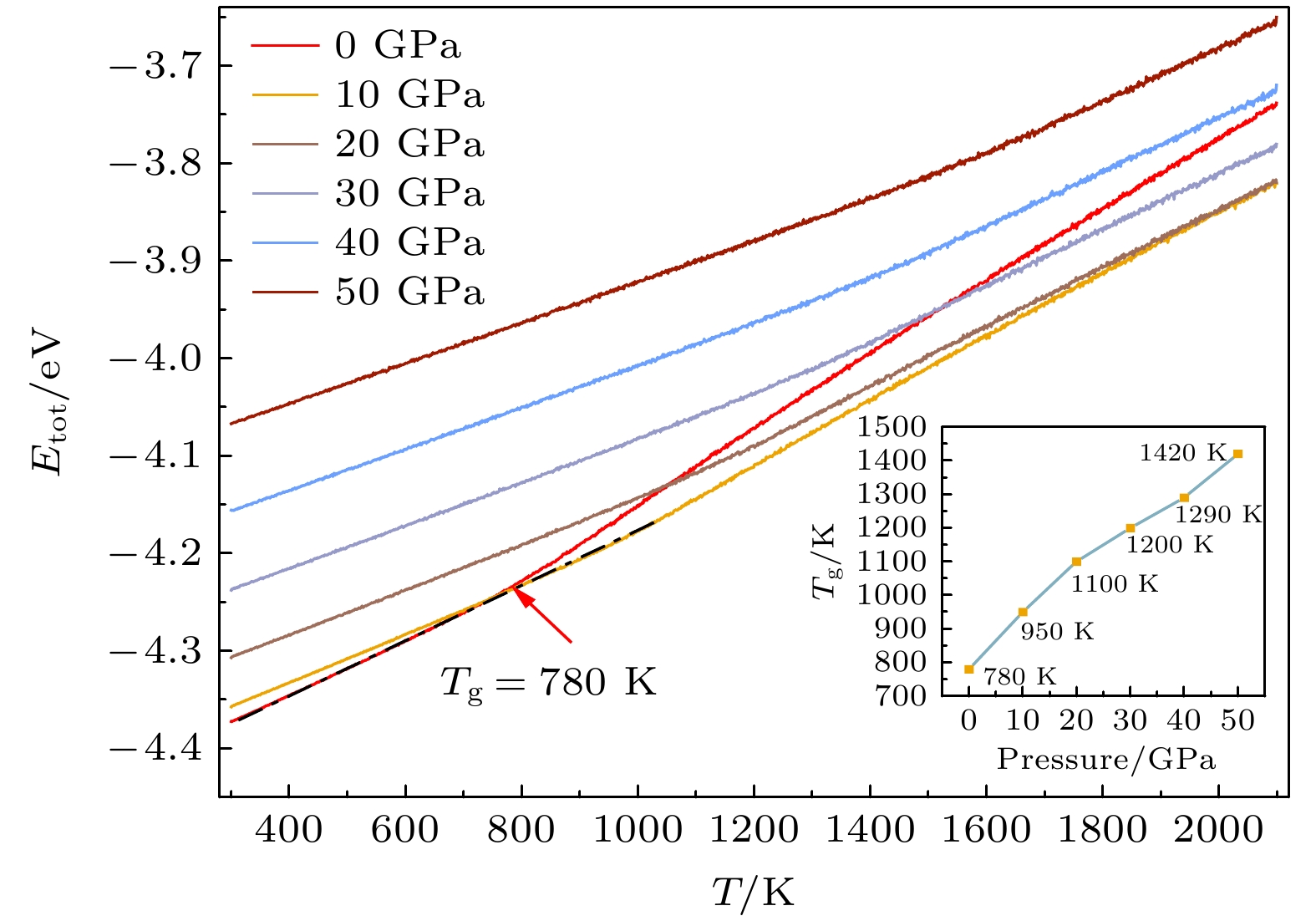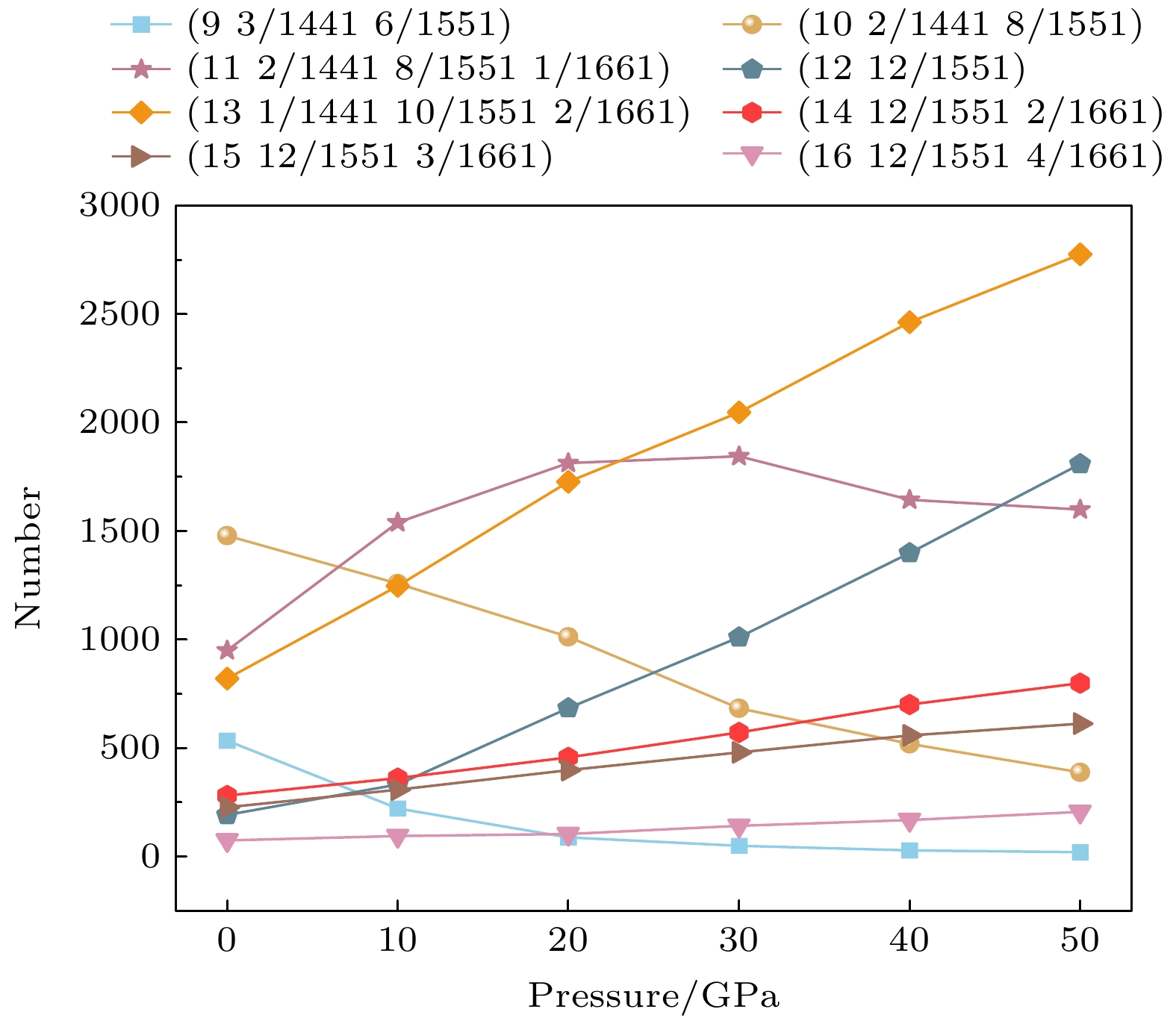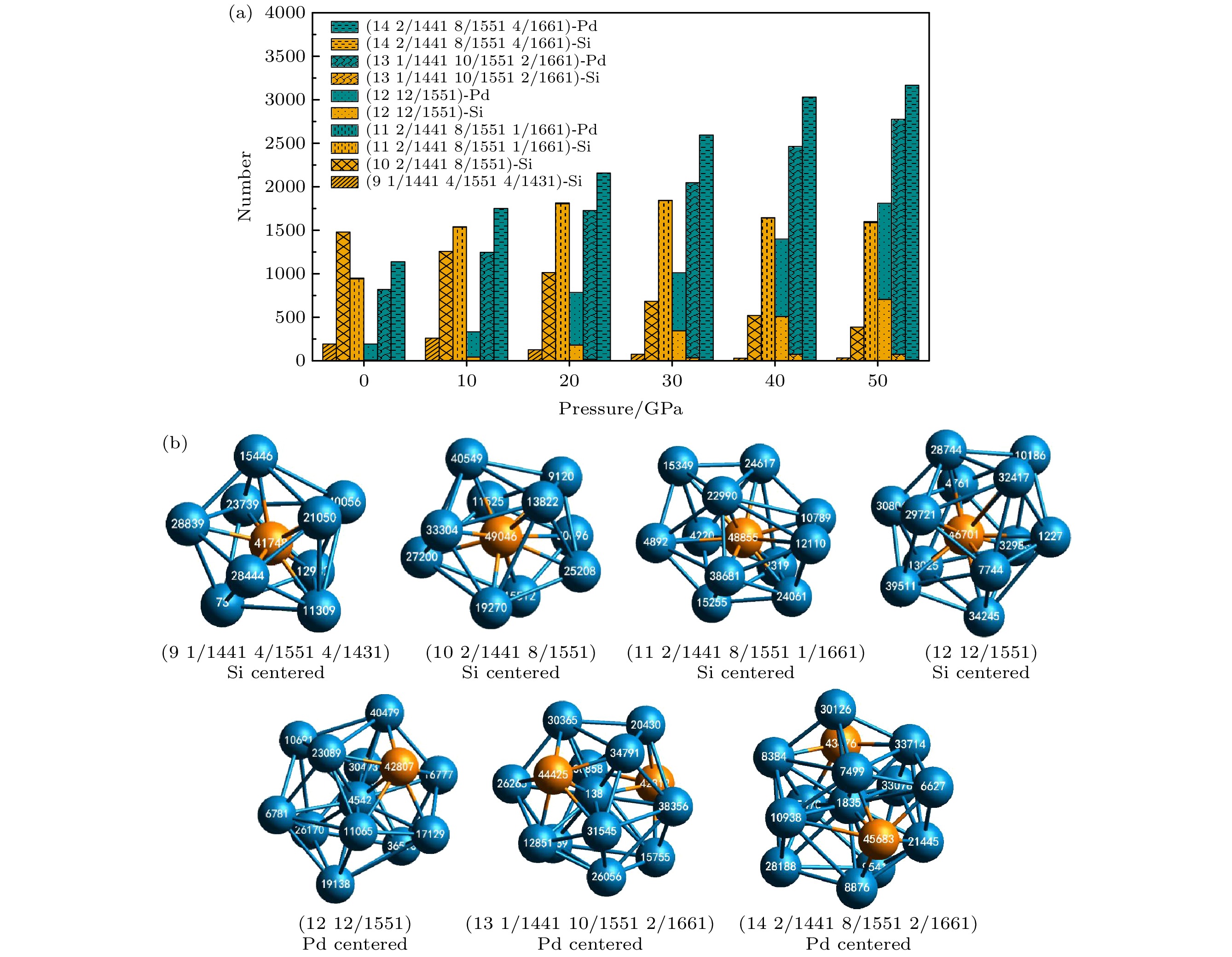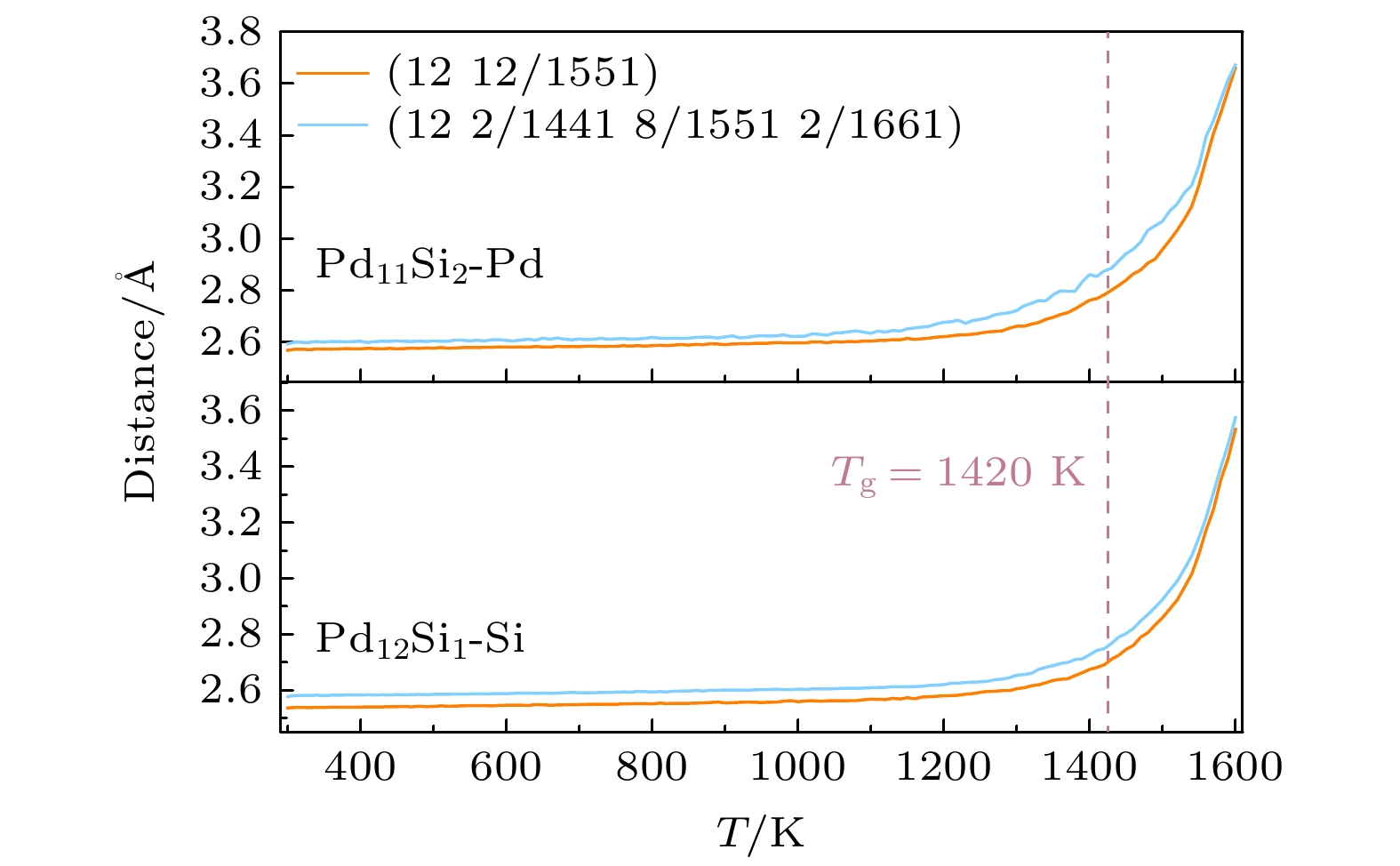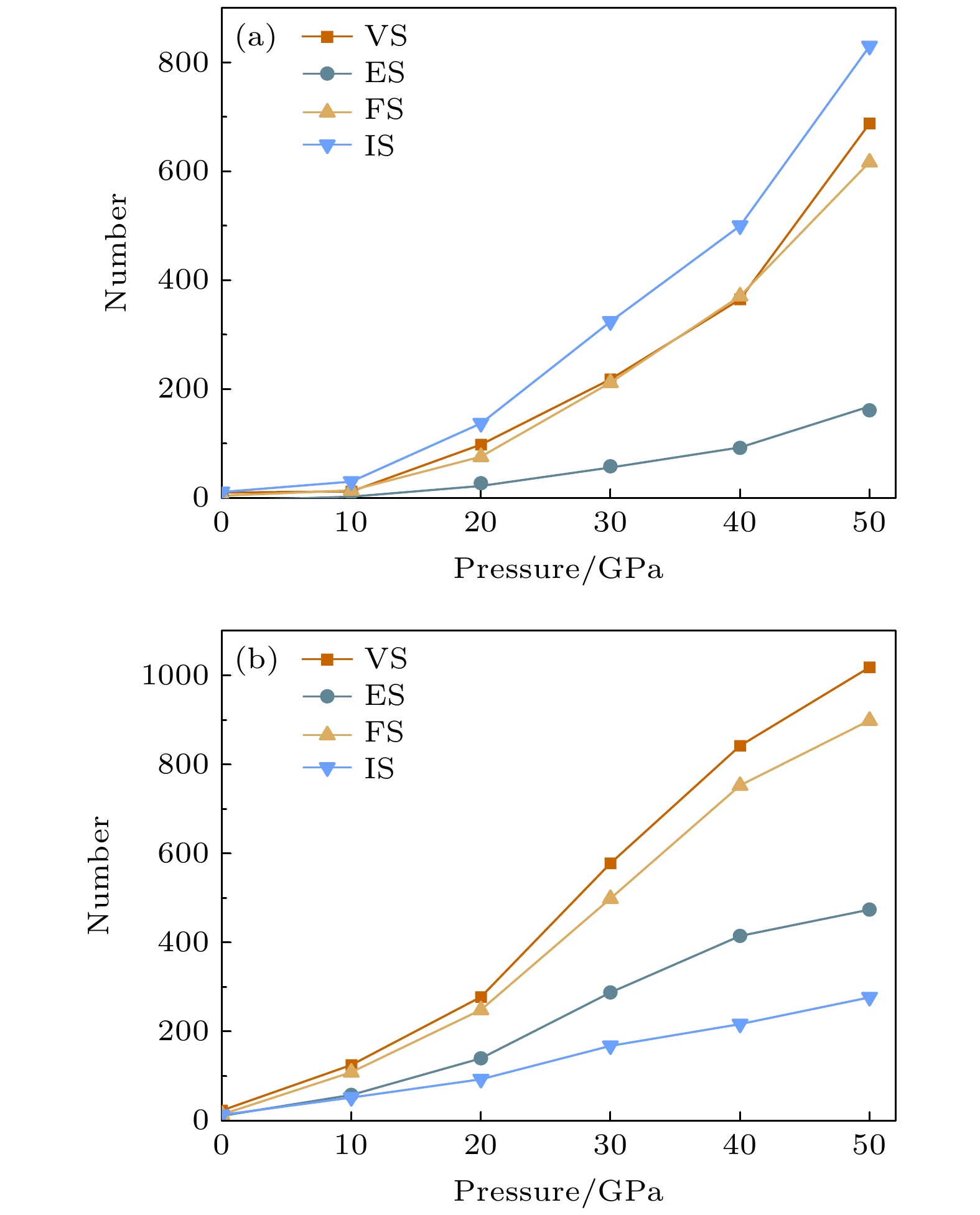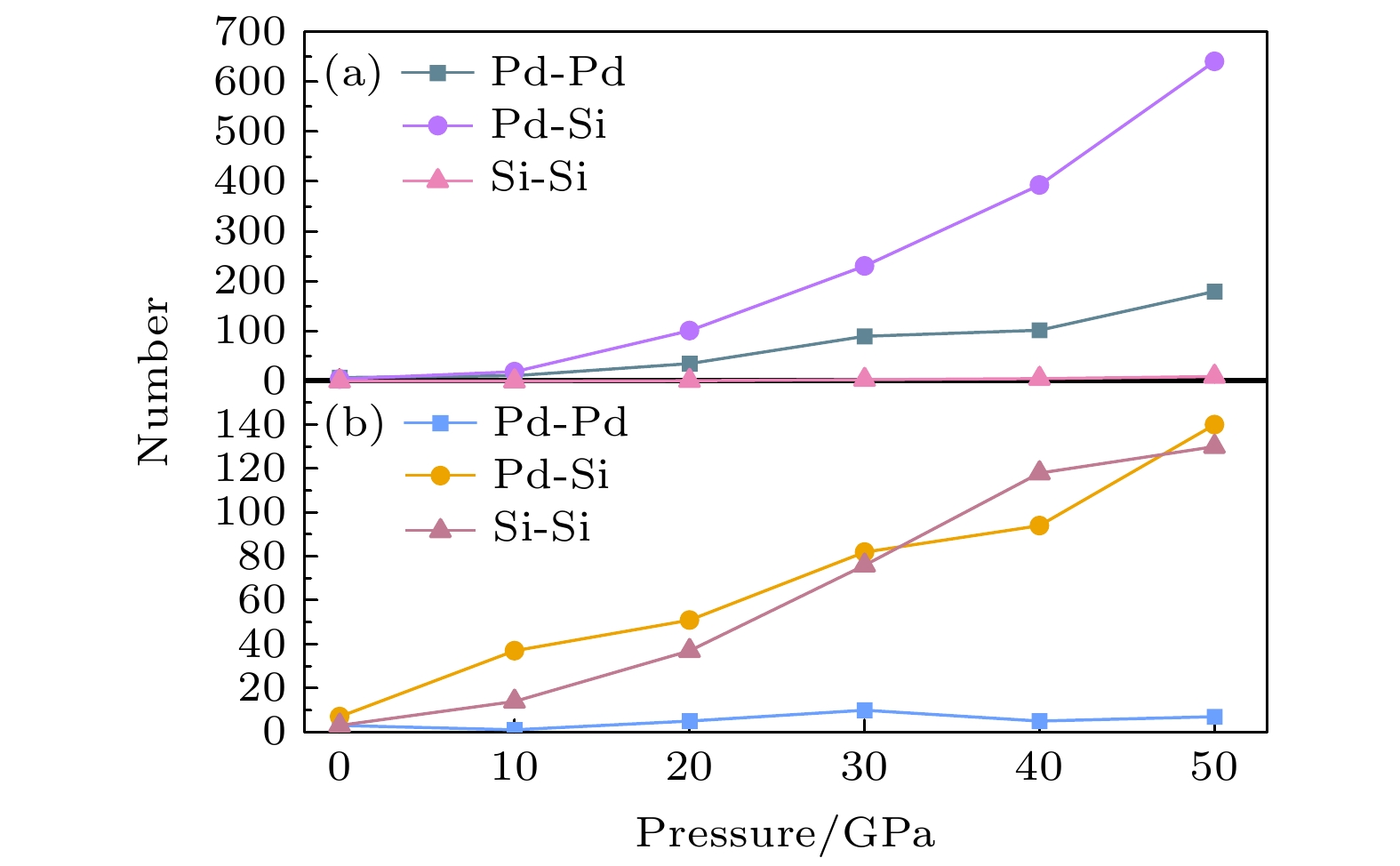-
Compared with traditional glass, metallic glass (MG) has excellent properties, such as high strength, high hardness, high fracture toughness, good soft magnetic properties and corrosion resistance due to its unique structure. Such properties enable it to be used in optics, electronics, construction and other fields, making it a highly promising new material with great application potential. As the properties of amorphous alloys are closely linked with their local structures, microstructure characteristics have always been a research focus in the amorphous field. Previous studies show that the onset temperature of heredity and the hereditary fraction of characteristic clusters can be used to effectively evaluate the glass-forming ability. In order to obtain the relationship between the microstructure characteristic and cluster evolution of amorphous alloy, and reveal the formation of glass, the glass transition processes of the Pd82Si18 alloy under different pressure conditions are simulated by using the molecular dynamics method, and the heredity and evolution of the Pd82Si18 amorphous alloy are analyzed by using the cluster-type index method and the reverse tracking method. The simulation results show that the glass transition temperature of the Pd82Si18 alloy can be increased when the pressure is higher, and a large number of icosahedra are formed in the solidified alloy when the pressure is sufficiently high. Icosahedron is a kind of structure that widely exists in amorphous materials and has been studied for quite a long time. In this work, a detailed comparative analysis of two icosahedra is conducted and the heritability of clusters with different chemical compositions under high pressure is studied. The results show that it is easier for icosahedra with central atom Pd and those with central atom Si to form a medium-range order in the Pd82Si18 amorphous alloy. An increase in pressure conduces to the increase of both onset temperature of heredity and hereditary fraction. Combined with the results of cluster heredity analysis at 0 GPa, the Si-centered clusters have stronger heritability than Pd-centered clusters, thus the former ones have a greater influence on the glass-forming ability. These findings are of significance in understanding the relationship between microstructure evolution and glass formation, and also providing certain guidance for designing amorphous alloys.
-
Keywords:
- molecular dynamics /
- high pressure /
- heredity /
- icosahedron
[1] Chen M W 2011 NPG Asia Mater. 3 82
 Google Scholar
Google Scholar
[2] Jiang H R, Bochtler B, Riegler S S, Wei X S, Neuber N, Frey M, Gallino I, Busch R, Shen J 2020 J. Alloys Compd. 844 156126
 Google Scholar
Google Scholar
[3] Hua N B, Chen W Z 2017 J. Alloys Compd. 693 816
 Google Scholar
Google Scholar
[4] Li H X, Lu Z C, Wang S L, Wu Y, Lu Z P 2019 Prog. Mater. Sci. 103 235
 Google Scholar
Google Scholar
[5] Yang Y J, Cheng B Y, Lv J W, Li B, Ma M Z, Zhang X Y, Li G, Liu R P 2019 Mater. Sci. Eng., A 746 229
 Google Scholar
Google Scholar
[6] Wang C J, He A N, Wang A D, Pang J, Liang X F, Li Q F, Chang C T, Qiu K Q, Wang X M 2017 Intermetallics 84 142
 Google Scholar
Google Scholar
[7] Jin Z S, Yang Y J, Zhang Z P, Ma X Z, Lv J W, Wang F L, Ma M Z, Zhang X Y, Liu R P 2019 J. Alloys Compd. 806 668
 Google Scholar
Google Scholar
[8] Liu S, Wang L F, Ge J C, Wu Z D, Ke Y B, Li Q, Sun B A, Feng T, Wu Y, Wang J T, Hahn H, Ren Y, Almer J D, Wang X L, Lan S 2020 Acta Mater. 200 42
 Google Scholar
Google Scholar
[9] Li F C, Liu T, Zhang J Y, Shuang S, Wang Q, Wang A D, Wang J G, Yang Y 2019 Mater. Today Adv. 4 100027
 Google Scholar
Google Scholar
[10] Wang W H, Dong C, Shek C H 2004 Mater. Sci. Eng. , R 44 45
 Google Scholar
Google Scholar
[11] Miracle D B, Senkov O N 2017 Acta Mater. 122 448
 Google Scholar
Google Scholar
[12] Abrosimova G E, Aronin A S 2017 Phys. Solid State 59 2248
 Google Scholar
Google Scholar
[13] Zhu L, Wang H, Wang Y C, Ma Y M, Cui Q L, Ma Y M, Zhou G T 2011 Phys. Rev. Lett. 106 145501
 Google Scholar
Google Scholar
[14] Sergueeva A V, Song C, Valiev R Z, Mukherjee A K 2003 Mater. Sci. Eng., A 339 159
 Google Scholar
Google Scholar
[15] Bazlov A I, Parkhomenko M S, Ubyivovk E V, Zanaeva E N, Gunderov D V, Louzguine-Luzgin D V 2022 J. Non-Cryst. Solids 576 121220
 Google Scholar
Google Scholar
[16] Galimzyanov B N, Doronina M A, Mokshin A V 2021 J. Non-Cryst. Solids 572 121102
 Google Scholar
Google Scholar
[17] Faruq M, Villesuzanne A, Shao G 2018 J. Non-Cryst. Solids 487 72
 Google Scholar
Google Scholar
[18] Hua D P, Ye W T, Jia Q, Zhou Q, Xia Q S, Shi J Q, Deng Y Y, Wang H F 2020 Appl. Surf. Sci. 511 145545
 Google Scholar
Google Scholar
[19] Barmpalexis P, Karagianni A, Katopodis K, Vardaka E, Kachrimanis K 2019 Eur. J. Pharm. Sci. 130 260
 Google Scholar
Google Scholar
[20] Verlet L 1967 Phys. Rev. 159 20
 Google Scholar
Google Scholar
[21] Sheng H W https:\\sites.google.com/site/eampotentials/ table/PdSi [2023-9-03
[22] Ojovan M I, Louzguine-Luzgin D V 2020 J. Phys. Chem. B 124 3186
 Google Scholar
Google Scholar
[23] Deng Y H, Wen D D, Li Y, Liu J, Peng P 2018 Philos. Mag. 98 2861
 Google Scholar
Google Scholar
[24] Zheng K F, Branicio P S 2020 Phys. Rev. Mater. 4 076001
 Google Scholar
Google Scholar
[25] Suzuki K, Hayashi N, Tomizuka Y, Fukunaga T, Kai K, Watanabe N 1984 J. Non-Cryst. Solids 61 637
 Google Scholar
Google Scholar
[26] Wen D D, Deng Y H, Liu J, Tian Z A, Peng P 2017 Comput. Mater. Sci. 140 275
 Google Scholar
Google Scholar
[27] Liu R S, Liu H R, Dong K J, Hou Z Y, Tian Z A, Peng P, Yu A B 2009 J. Non-Cryst. Solids 355 541
 Google Scholar
Google Scholar
[28] Liu R S, Dong K J, Li J Y, Yu A B, Zou R P 2005 J. Non-Cryst. Solids 351 612
 Google Scholar
Google Scholar
[29] Wen D D, Deng Y H, Gao M, Tian Z A 2021 Chin. Phys. B 30 076101
 Google Scholar
Google Scholar
[30] Wen D D, Peng P, Jiang Y Q, Tian Z A, Li W, Liu R S 2015 J. Non-Cryst. Solids 427 199
 Google Scholar
Google Scholar
-
-
[1] Chen M W 2011 NPG Asia Mater. 3 82
 Google Scholar
Google Scholar
[2] Jiang H R, Bochtler B, Riegler S S, Wei X S, Neuber N, Frey M, Gallino I, Busch R, Shen J 2020 J. Alloys Compd. 844 156126
 Google Scholar
Google Scholar
[3] Hua N B, Chen W Z 2017 J. Alloys Compd. 693 816
 Google Scholar
Google Scholar
[4] Li H X, Lu Z C, Wang S L, Wu Y, Lu Z P 2019 Prog. Mater. Sci. 103 235
 Google Scholar
Google Scholar
[5] Yang Y J, Cheng B Y, Lv J W, Li B, Ma M Z, Zhang X Y, Li G, Liu R P 2019 Mater. Sci. Eng., A 746 229
 Google Scholar
Google Scholar
[6] Wang C J, He A N, Wang A D, Pang J, Liang X F, Li Q F, Chang C T, Qiu K Q, Wang X M 2017 Intermetallics 84 142
 Google Scholar
Google Scholar
[7] Jin Z S, Yang Y J, Zhang Z P, Ma X Z, Lv J W, Wang F L, Ma M Z, Zhang X Y, Liu R P 2019 J. Alloys Compd. 806 668
 Google Scholar
Google Scholar
[8] Liu S, Wang L F, Ge J C, Wu Z D, Ke Y B, Li Q, Sun B A, Feng T, Wu Y, Wang J T, Hahn H, Ren Y, Almer J D, Wang X L, Lan S 2020 Acta Mater. 200 42
 Google Scholar
Google Scholar
[9] Li F C, Liu T, Zhang J Y, Shuang S, Wang Q, Wang A D, Wang J G, Yang Y 2019 Mater. Today Adv. 4 100027
 Google Scholar
Google Scholar
[10] Wang W H, Dong C, Shek C H 2004 Mater. Sci. Eng. , R 44 45
 Google Scholar
Google Scholar
[11] Miracle D B, Senkov O N 2017 Acta Mater. 122 448
 Google Scholar
Google Scholar
[12] Abrosimova G E, Aronin A S 2017 Phys. Solid State 59 2248
 Google Scholar
Google Scholar
[13] Zhu L, Wang H, Wang Y C, Ma Y M, Cui Q L, Ma Y M, Zhou G T 2011 Phys. Rev. Lett. 106 145501
 Google Scholar
Google Scholar
[14] Sergueeva A V, Song C, Valiev R Z, Mukherjee A K 2003 Mater. Sci. Eng., A 339 159
 Google Scholar
Google Scholar
[15] Bazlov A I, Parkhomenko M S, Ubyivovk E V, Zanaeva E N, Gunderov D V, Louzguine-Luzgin D V 2022 J. Non-Cryst. Solids 576 121220
 Google Scholar
Google Scholar
[16] Galimzyanov B N, Doronina M A, Mokshin A V 2021 J. Non-Cryst. Solids 572 121102
 Google Scholar
Google Scholar
[17] Faruq M, Villesuzanne A, Shao G 2018 J. Non-Cryst. Solids 487 72
 Google Scholar
Google Scholar
[18] Hua D P, Ye W T, Jia Q, Zhou Q, Xia Q S, Shi J Q, Deng Y Y, Wang H F 2020 Appl. Surf. Sci. 511 145545
 Google Scholar
Google Scholar
[19] Barmpalexis P, Karagianni A, Katopodis K, Vardaka E, Kachrimanis K 2019 Eur. J. Pharm. Sci. 130 260
 Google Scholar
Google Scholar
[20] Verlet L 1967 Phys. Rev. 159 20
 Google Scholar
Google Scholar
[21] Sheng H W https:\\sites.google.com/site/eampotentials/ table/PdSi [2023-9-03
[22] Ojovan M I, Louzguine-Luzgin D V 2020 J. Phys. Chem. B 124 3186
 Google Scholar
Google Scholar
[23] Deng Y H, Wen D D, Li Y, Liu J, Peng P 2018 Philos. Mag. 98 2861
 Google Scholar
Google Scholar
[24] Zheng K F, Branicio P S 2020 Phys. Rev. Mater. 4 076001
 Google Scholar
Google Scholar
[25] Suzuki K, Hayashi N, Tomizuka Y, Fukunaga T, Kai K, Watanabe N 1984 J. Non-Cryst. Solids 61 637
 Google Scholar
Google Scholar
[26] Wen D D, Deng Y H, Liu J, Tian Z A, Peng P 2017 Comput. Mater. Sci. 140 275
 Google Scholar
Google Scholar
[27] Liu R S, Liu H R, Dong K J, Hou Z Y, Tian Z A, Peng P, Yu A B 2009 J. Non-Cryst. Solids 355 541
 Google Scholar
Google Scholar
[28] Liu R S, Dong K J, Li J Y, Yu A B, Zou R P 2005 J. Non-Cryst. Solids 351 612
 Google Scholar
Google Scholar
[29] Wen D D, Deng Y H, Gao M, Tian Z A 2021 Chin. Phys. B 30 076101
 Google Scholar
Google Scholar
[30] Wen D D, Peng P, Jiang Y Q, Tian Z A, Li W, Liu R S 2015 J. Non-Cryst. Solids 427 199
 Google Scholar
Google Scholar
计量
- 文章访问数: 4981
- PDF下载量: 77
- 被引次数: 0













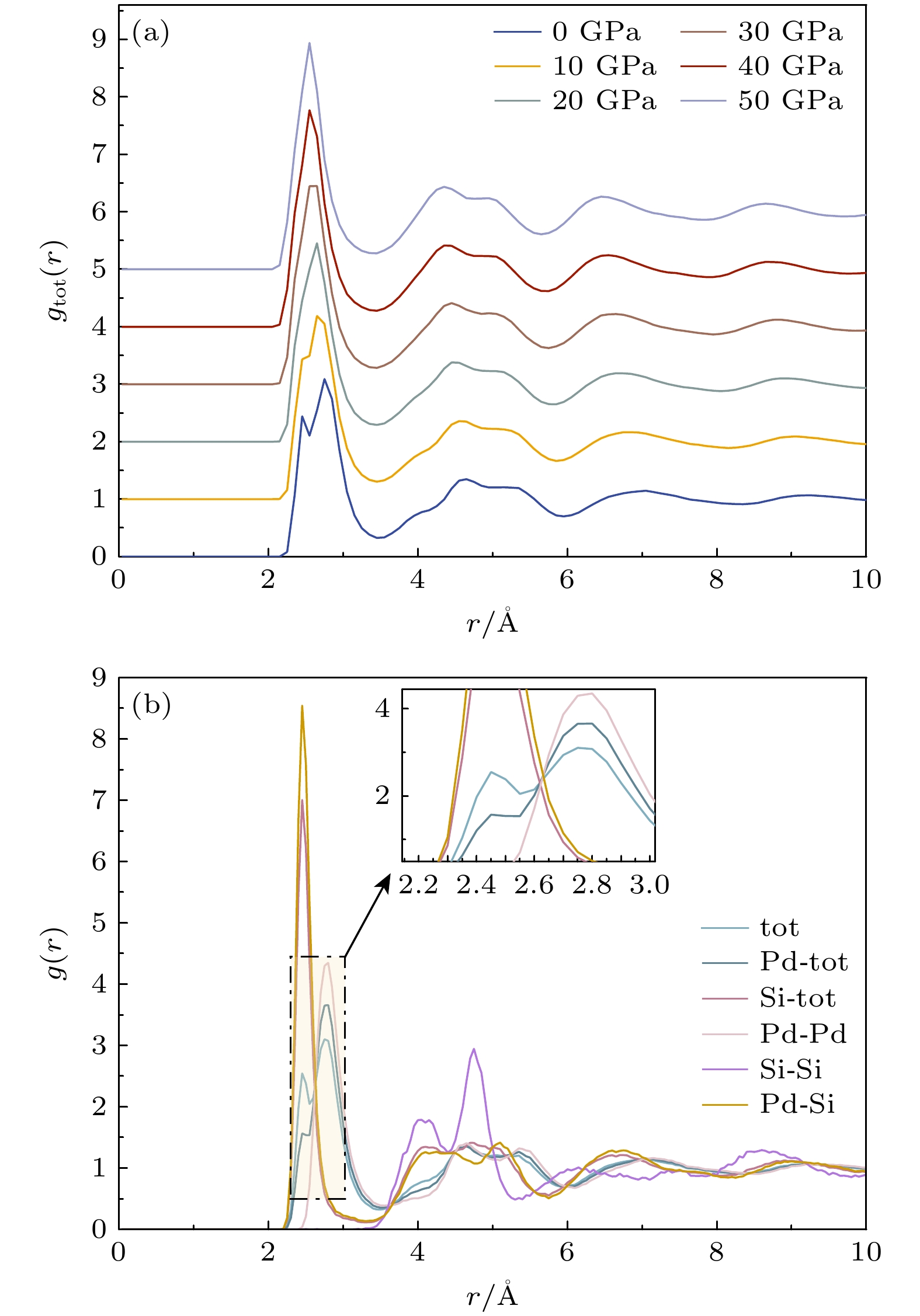
 下载:
下载:
